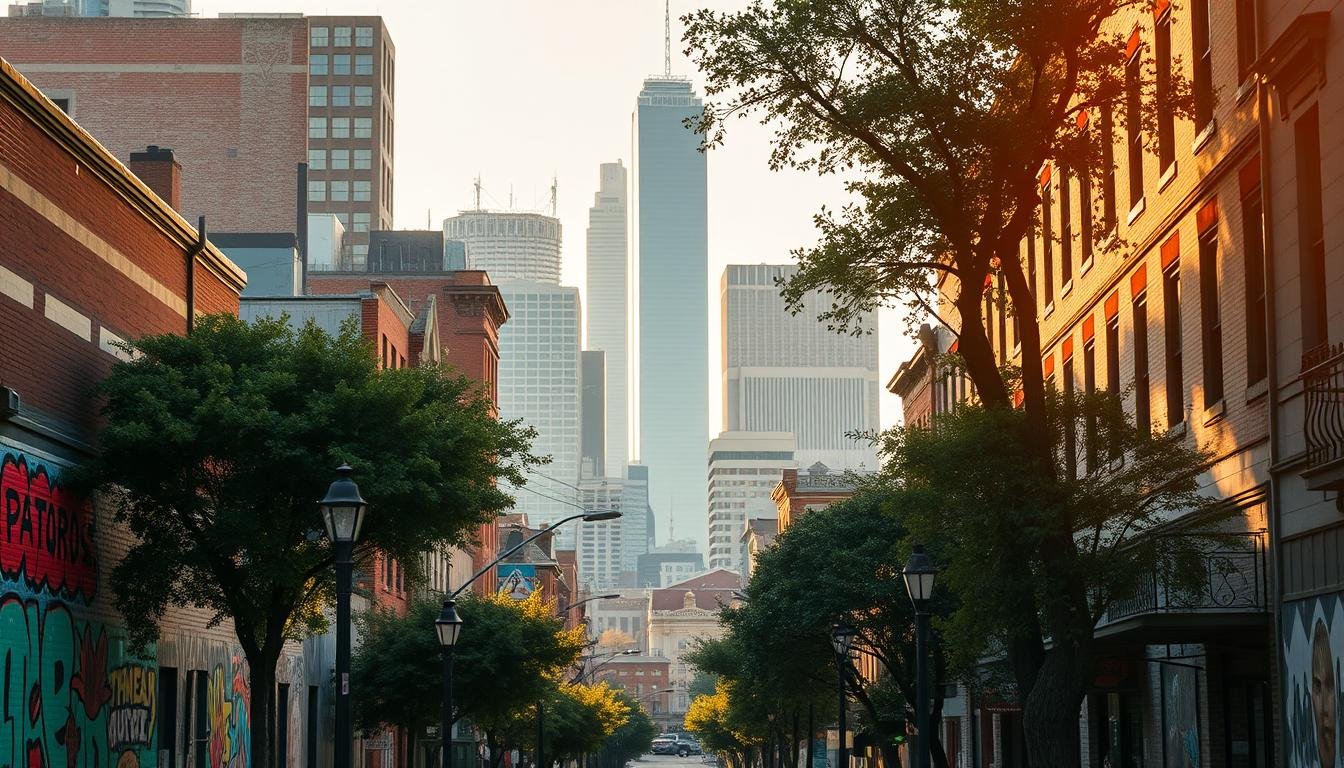Houston’s Third Ward stands as a living archive of African American history, creativity, and civic resilience. Established in the late 1800s as a haven for freed people and their descendants, the neighborhood evolved into a vibrant hub of Black arts, education, and entrepreneurship just southeast of downtown.
Anchored by institutions like Emancipation Park, Texas Southern University, Project Row Houses, and the historic Eldorado Ballroom, Third Ward reflects a powerful story of continuity and change. These cultural landmarks have shaped a strong community identity and a rich Black cultural fabric that links past struggles to present-day innovation.
Today, Third Ward balances residential life, Black-owned businesses, and public spaces while navigating development pressures and displacement risks. Its story echoes the legacy of other historic districts like Bronzeville in Chicago and Sweet Auburn Avenue in Atlanta, where preservation and reinvestment fuel community resilience.
To explore similar efforts across the country, visit Black Wall Streets Across America: City Guides to Historic and Modern Hubs of Black Economic Power, a growing archive of neighborhoods reclaiming legacy through culture, commerce, and collaboration.
Key Takeaways
- The neighborhood is a focal point of African American history and culture in the city.
- Historic sites and institutions anchor community identity and public life.
- Residential, commercial, and cultural uses coexist, reflecting local vitality.
- Ongoing programs and organizations support business and artistic growth.
- The area links heritage with contemporary efforts to sustain community place-making.
🗺️ Third Ward at a Glance: Roots, People, and Place in Houston’s Historic Black Wall Street
Just southeast of downtown Houston, Third Ward is a compact neighborhood with deep roots in post–Civil War community building and Black cultural resilience. Established as one of the city’s original numbered wards after Houston’s 1836 founding, Third Ward became a sanctuary for freed people and their descendants in the late 1800s.
Its boundaries—stretching from I‑45 to State Highway 288/I‑69, and from Wheeler and Blodgett to Texas Spur 5—form a clear civic frame that guides both residents and visitors through a landscape rich in history and transformation.
The neighborhood’s legacy is shaped by people, traditions, and institutions that fostered a lasting sense of home. Texas Southern University, one of the nation’s largest historically Black colleges and universities (HBCUs), serves as an educational and cultural anchor, amplifying arts, scholarship, and civic engagement across Houston.
Today, Third Ward’s art scene remains vibrant, with local artists, galleries, and public projects continuing the legacy of creative expression. For a deeper historical snapshot, explore Houston’s Third Ward history and its role in shaping Black economic power in Texas.
To see how Third Ward connects to other legacy-rich districts, visit Black Wall Streets Across America: City Guides to Historic and Modern Hubs of Black Economic Power, including Boley, Oklahoma and Fillmore District in San Francisco.
✊🏾 Houston’s Third Ward: Black Legacy, Cultural Resilience, and Civil Rights Leadership
Throughout the 20th century, Houston’s Third Ward became a powerful center of Black civic energy, political organizing, and creative practice. Local leaders, students, clergy, and artists transformed neighborhood spaces into hubs for activism and cultural expression—making Third Ward a cornerstone of the civil rights movement in Houston.
This legacy mirrors the civic power found in Jackson Ward in Richmond and Bronzeville in Chicago, where community organizing and cultural production fueled long-term resilience.
🕊️ Civil Rights Milestones and Community Leadership
The civil rights movement in Third Ward traces back to Reconstruction, gaining momentum through the mid‑20th century. Emancipation Park, originally purchased by formerly enslaved residents in 1872, became a symbolic gathering place for marches, meetings, and public remembrance.
Texas Southern University played a pivotal role in amplifying student activism and faculty leadership, helping shape public policy and expand voting and educational rights. Clergy and residents partnered with campus allies to push for equity—echoing the collaborative spirit seen in Durham’s Hayti District.
🛠️ From Reconstruction to Present: Neighborhood Evolution and Resilience
Despite challenges like the construction of Highway 288, redlining, and ongoing development pressures, Third Ward has sustained its cultural and civic identity. Arts initiatives and community leadership have kept memory alive and anchored local pride.
- Project Row Houses transformed historic homes into centers for art, education, and leadership
- Public art and community programs documented struggle and celebrated resilience
- Local leaders balanced rights protection with practical neighborhood needs
Third Ward’s evolution reflects the broader story of Black Wall Street districts across America—where culture, commerce, and community organizing remain intertwined. To explore similar legacies, visit Black Wall Streets Across America: City Guides to Historic and Modern Hubs of Black Economic Power.
For a guided perspective on key sites and stories, see the historic tour of places that shaped this community’s history.
🏛️ Institutions and Landmarks: Texas Southern University, Emancipation Park, and Eldorado Ballroom
Three landmark sites—Texas Southern University, Emancipation Park, and the Eldorado Ballroom—form the backbone of Third Ward’s cultural identity, linking scholarship, public gatherings, and Black music history across generations.
These institutions reflect the same civic and cultural power found in Beale Street in Memphis and Jackson Ward in Richmond, where legacy spaces continue to shape community life.
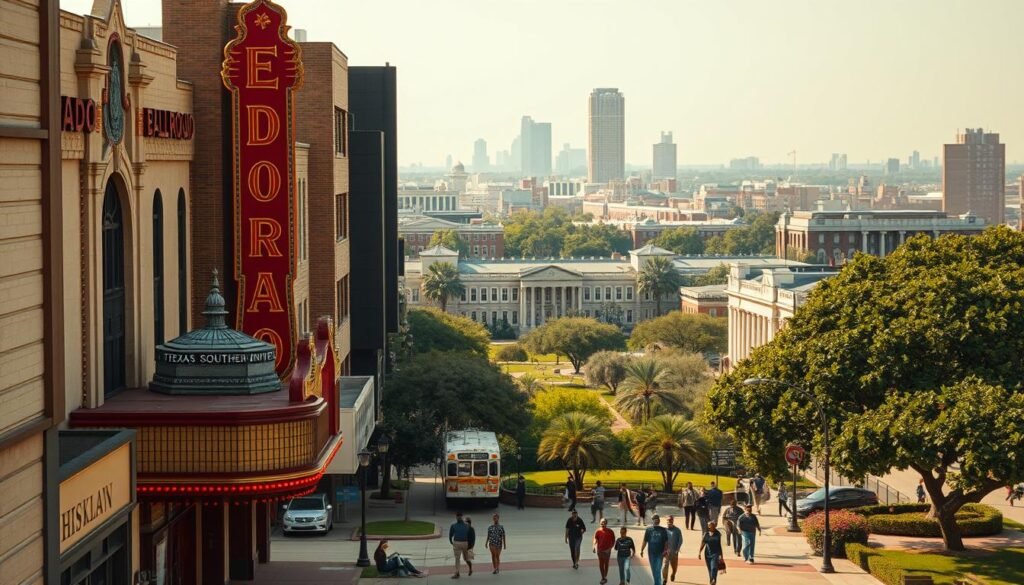
🎓 Texas Southern University: Education, Activism, and Cultural Impact
Founded in 1927, Texas Southern University (TSU) has long served as a catalyst for education, activism, and civic leadership in Houston. During the civil rights era, TSU empowered student organizers and trained many of the city’s most influential Black leaders.
Today, TSU’s programs continue to drive research, public debate, and arts engagement that extend beyond the campus into surrounding neighborhoods. Its role mirrors the educational impact of institutions like Howard University in D.C. and North Carolina Central University in Durham’s Hayti District.
🌳 Emancipation Park: Freedom, History, and Community Events
Emancipation Park, purchased in 1872 by formerly enslaved residents, remains a vital public square for memory, celebration, and recreation. It hosts cultural festivals, neighborhood programming, and community events that reinforce cohesion and visible history.
The park’s legacy aligns with other civic spaces like Bronzeville’s Victory Monument and Sweet Auburn’s King Center, where public gathering sites honor Black freedom and foster ongoing engagement.
🎶 Eldorado Ballroom: Music Heritage and Recent Renovation
The historic Eldorado Ballroom earned its reputation as a premier African American music venue, hosting legends like B.B. King and Lightnin’ Hopkins. Gifted to Project Row Houses in 1999, the ballroom underwent a $9.6 million renovation and reopened in March 2023.
Today, it anchors arts programming, concerts, and educational initiatives for artists and families—serving as a living venue that connects Black music heritage to community development. Its revival echoes efforts in San Francisco’s Fillmore District and Los Angeles’ Central Avenue.
🎨 Arts and Culture in Third Ward: Project Row Houses, Local Artists, and Community Storytelling
In Houston’s Third Ward, art is more than expression—it’s infrastructure. Modest shotgun homes have been transformed into stages for public life, social change, and community storytelling, making the neighborhood a national model for community-engaged art.
This creative legacy echoes efforts in Bronzeville, Chicago and Fillmore District in San Francisco, where art and activism remain deeply intertwined.
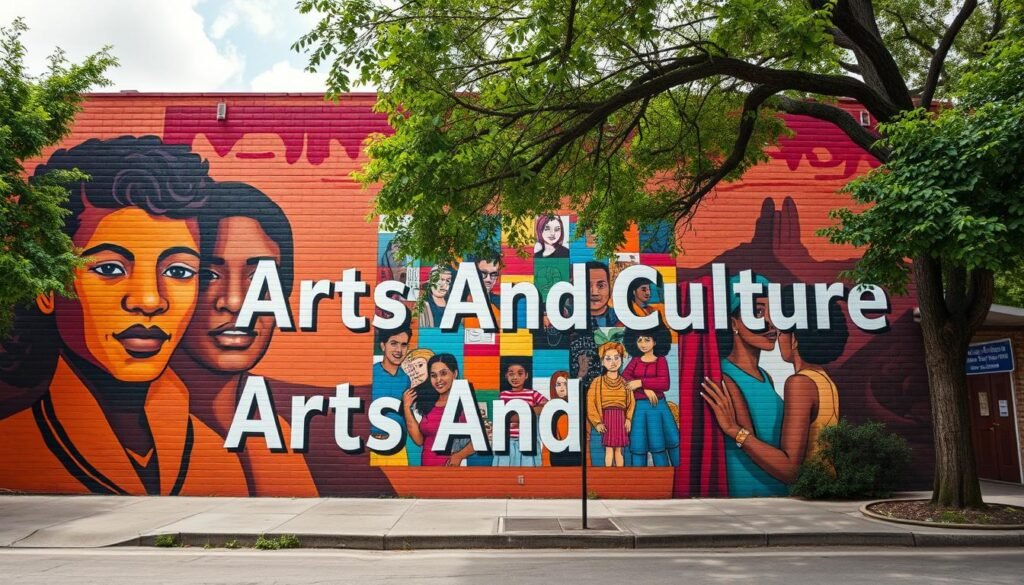
🏠 Project Row Houses: Shotgun Homes, Social Sculpture, and Artist Rounds
Founded in 1993 by artist Rick Lowe, Project Row Houses reimagined 22 shotgun homes at Holman and Live Oak as a canvas for community-driven art. Early support included:
- $25,000 from the National Endowment for the Arts (NEA)
- $113,000 from foundations and donors
- $136,000 in in-kind materials
- A $120,000 no-interest loan to secure the properties
The Drive By exhibition (1994) launched the now-iconic biannual Artist Rounds, which continue to anchor arts education, civic participation, and the Young Mothers Residential Program (established in 1996).
🖌️ Local Artists and Murals: Identity, Advocacy, and Public Art
Third Ward’s public art scene is shaped by creators like Israel McCloud, Ryan N. Dennis, and Marc Furi, whose project I Love 3W explores themes of gentrification, belonging, and Black identity. Murals and installations across the neighborhood serve as visual archives of struggle, joy, and resistance.
🎭 Galleries, Theaters, and The Ensemble Theatre
Founded in 1976, The Ensemble Theatre remains one of the largest African American professional theaters in the U.S., strengthening Houston’s regional arts ecosystem. Nearby galleries and small venues amplify local voices, offering professional pathways for emerging artists and cultural workers.
🛡️ Preservation, Gentrification, and Cultural Stewardship
As development pressures rise, preservation efforts in Third Ward aim to balance change with cultural stewardship. Community-led strategies focus on:
- Protecting arts assets and historic homes
- Preserving memory sites tied to Black history
- Keeping culture visible for future generations
These efforts mirror preservation models seen in Durham’s Hayti District and Sweet Auburn Avenue in Atlanta, where art and memory fuel long-term resilience.
🍽️ Food and Dining in Third Ward: Soul Food, Global Flavors, and Culinary Events
Third Ward’s food scene is a cornerstone of neighborhood life, blending longtime diners with new culinary ventures that shape daily rhythms and community pride. The area offers a flavorful mix of soul food staples, Italian, Mexican, Asian, and modern American cuisine, reflecting both heritage and innovation.
Visitors can explore roughly 30 restaurants, two local markets, and several annual food events that celebrate taste, culture, and Black entrepreneurship. This culinary diversity mirrors the food corridors of Beale Street in Memphis and Newark’s High Street, where dining supports legacy and local commerce.
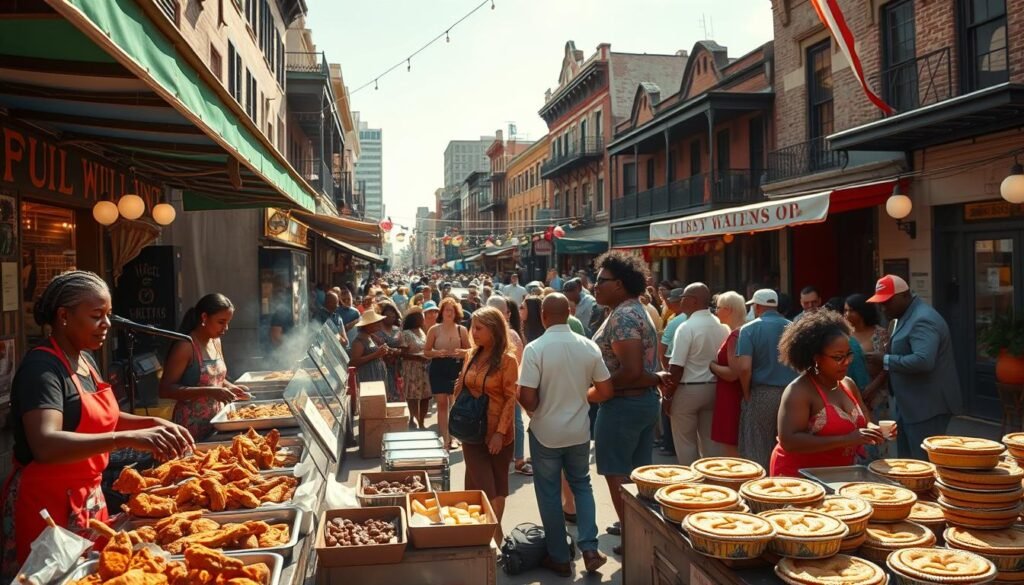
🌟 Signature Spots: The Breakfast Klub and The Turkey Leg Hut
Two standout restaurants anchor Third Ward’s reputation for bold, soulful flavors:
- The Breakfast Klub is renowned for chicken and waffles and catfish and grits, drawing long lines and loyal patrons from across the region.
- The Turkey Leg Hut is famous for its stuffed turkey legs and inventive seasoning, attracting crowds and fueling local business growth.
Both establishments serve as culinary landmarks, reinforcing Third Ward’s role in Houston’s Black-owned restaurant ecosystem.
📊 Cuisine Diversity and Dining Metrics
| Metric | Count | Top Cuisines | Impact |
| Restaurants | ~30 | Italian, Mexican, American, Asian | Job creation, entrepreneurship |
| Markets | 2 | Fresh produce, artisan goods | Small vendor income |
| Food Events/Year | ~4 | Soul food showcases, pop-ups | Tourism, neighborhood visibility |
🎉 Festivals and Markets: Soul Food Festival and Third Ward Farmers Market
The Soul Food Festival celebrates heritage recipes, healthy options, and Black culinary traditions, bringing together chefs, vendors, and musicians in a shared public space. It’s a vibrant example of how food fosters community celebration and cultural preservation.
“Local markets connect producers, small businesses, and families in meaningful ways.”
The Third Ward Farmers Market offers fresh produce, artisan goods, and a platform for local artists—serving as a meeting point where food, art, and commerce converge to strengthen the neighborhood’s economic and cultural profile.
Neighborhood Eats Near Southeast Downtown Houston
Proximity to southeast downtown draws diners from across the city who seek authentic options. Food choices range from soul food classics to international fare, reflecting evolving tastes.
- Signature destinations elevate the neighborhood’s culinary profile.
- Dining metrics show variety and steady economic benefit.
- Events and markets tie food to arts programming and community life.
🧰 Community Programs and Resources: Mobility, Tools, and Public Services in Third Ward
Third Ward’s community infrastructure is supported by a coordinated network of mobility services, equipment lending, and public assistance programs that enhance daily life and empower neighborhood projects. These initiatives reflect the same grassroots ingenuity seen in Boley, Oklahoma and Paradise Valley in Detroit, where local solutions drive long-term resilience.
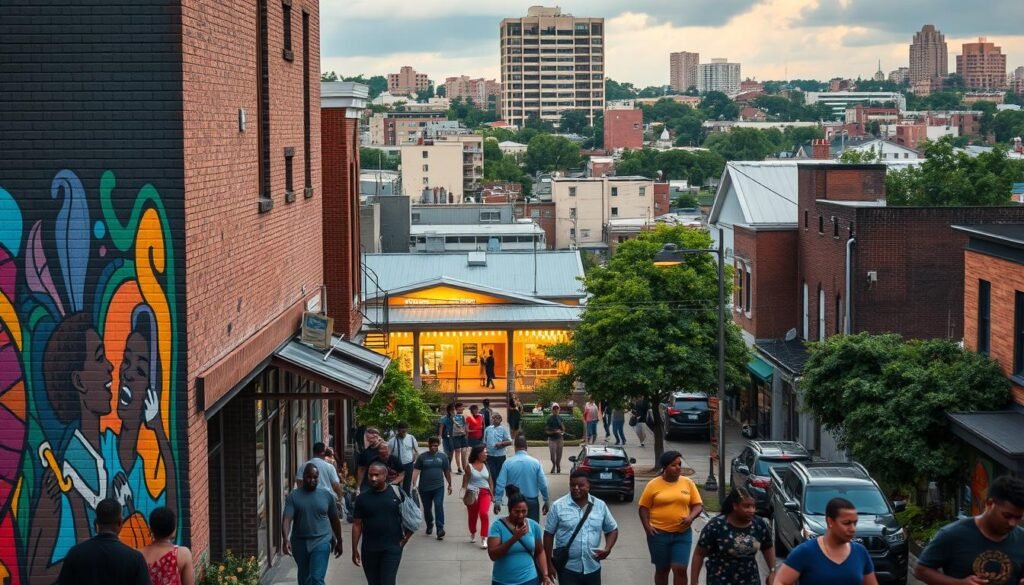
🚐 RYDE’s Free Electric Shuttle: Transit Access and Equity
RYDE offers a free, 100% electric on-demand shuttle service for Third Ward residents, operating Monday–Friday, 8am–4pm. Riders can request trips via the Ride Circuit app, improving first-last mile connectivity to:
- Transit hubs
- Jobs and schools
- Clinics and grocery stores
This service is especially impactful in areas classified as food deserts, helping bridge gaps in mobility equity and essential access.
🔧 Houston ToolBank: Lending Equipment for Community Projects
The Houston ToolBank expands capacity for nonprofits, volunteers, and neighborhood organizers by providing access to:
- 299 tool types
- 15,000+ tools
- Event equipment
This resource lowers barriers for community-led builds, public events, and local beautification efforts, reinforcing Third Ward’s tradition of self-determined development.
🏠 CenterPoint Energy’s Agencies in Action: Utility Assistance and Support
Agencies in Action helps qualifying residents—including those receiving SNAP, SSI, or living in public housing—access home efficiency support and utility assistance. Residents can:
- Call 855-751-6432
- Visit CenterPointEnergy.com/AgenciesinAction for eligibility and enrollment
🌳 311, Urban Forestry, and Outage Tracker: Staying Informed and Connected
Residents can report tree, lighting, or street issues using Houston’s 311 service or the Urban Forestry program. For real-time updates on power outages, visit the CenterPoint Outage Tracker.
🧭 Summary of Community Access Tools
- Mobility Options: RYDE improves access to essential services and transit connections
- Equipment Resources: ToolBank lending lowers barriers for community-led projects and events
- Assistance Programs: CenterPoint’s initiative helps qualifying residents with home efficiency and support
- Service Access: 311, Urban Forestry, and the Outage Tracker let residents report issues and stay informed
🚦 Getting Around Third Ward: Boundaries, Transit, and Housing Context
Third Ward’s compact urban footprint—less than a mile southeast of downtown Houston—shapes its travel patterns, housing demand, and access to jobs and services. Its proximity to the city core makes multimodal transportation essential for residents, students, and visitors.
🗺️ Neighborhood Boundaries: I-45, Highway 288/I-69, Wheeler-Blodgett, and Texas Spur 5
Third Ward’s official boundaries stretch:
- North: I-45
- West: State Highway 288/I-69
- South: Wheeler and Blodgett
- East: Texas Spur 5
These corridors help orient residents to major access points into central Houston. However, the construction of Highway 288 historically cut through the community, disrupting housing continuity and neighborhood cohesion—a pattern seen in other Black districts like Los Angeles’ Central Avenue and Detroit’s Paradise Valley.
🚍 Transportation Options and Connectivity to Downtown Houston
Third Ward benefits from multimodal transit options that support daily commutes, school access, and cultural engagement:
- RYDE’s free electric shuttle offers first-last mile service within the neighborhood
- METRO bus and rail routes connect Third Ward to downtown, Midtown, and Museum District destinations
- Walkable streets and bike-friendly corridors enhance local mobility
These options improve access to jobs, schools, healthcare, and arts venues, reinforcing Third Ward’s role as a livable, connected Black cultural district.
🧭 Summary of Mobility and Housing Context
- Boundaries Clarified: Primary corridors frame mobility and planning decisions
- Historical Impact: Highway construction reshaped neighborhood cohesion and housing trends
- Practical Options: Shuttles, bus, and rail support daily commutes and service access
For planners and residents seeking detailed infrastructure data, consult the city’s planning report at planning report. It offers maps and context that inform housing policy and mobility projects.
💼 Opportunities and Challenges: Small Business, Events, and Community-Led Revitalization in Third Ward
Third Ward continues to evolve through community-led revitalization, with a focused push on markets, grants, and arts-based placemaking that creates measurable opportunities for local entrepreneurs, vendors, and residents. These efforts mirror similar strategies in Sweet Auburn Avenue in Atlanta and Bronzeville in Chicago, where culture and commerce work hand in hand.
🛍️ Entrepreneurship, Markets, and Local Business Support
Pop-up events and recurring markets—such as the Third Ward Farmers Market—offer platforms for Black-owned businesses, local producers, and creatives to earn income and build clientele. These events also serve as testing grounds for new ideas and products.
Support programs include:
- Small business grants
- Entrepreneurship training
- Shared retail models
These tools aim to keep wealth circulating locally, reinforcing Third Ward’s legacy as a Black economic hub.
🌿 Health, Green Spaces, and Healthy Outdoor Communities
Public-space upgrades and health-focused programming link parks to better outcomes for residents. Healthy Outdoor Communities hosts bi-monthly meetings that allow residents to shape public space plans, ensuring that revitalization reflects community needs.
Project Row Houses also contributes through:
- Tutoring and youth enrichment
- Financial empowerment workshops
- Food distribution programs
These initiatives support neighborhood development while preserving local culture and civic memory.
📊 Opportunities and Challenges Overview
| Category | Primary Opportunity | Main Challenge | Key Resource |
| Markets & Events | Vendor income, visibility | Seasonal demand, space limits | Third Ward Farmers Market |
| Small Business | Job creation, entrepreneurship | Access to capital, rising rents | Grant Programs |
| Public Health & Parks | Community wellness, gatherings | Maintenance funding | Healthy Outdoor Communities |
- Small business support scales jobs and keeps investment local
- Community programs and events strengthen civic ties and foster innovation
- Affordable housing and equitable planning remain core challenges for long-term stability
- Artists and cultural initiatives play a key role in branding and attracting visitors
🏁 Conclusion: Third Ward’s Legacy of Leadership, Culture, and Inclusive Growth
Houston’s Third Ward continues to lead through a powerful mix of civic spaces, educational campuses, and arts-driven community projects. Anchored by Emancipation Park, Texas Southern University, Project Row Houses, and the Eldorado Ballroom, the neighborhood remains a beacon of Black cultural resilience and community innovation.
The identity of Third Ward Houston rests on the people who protect homes, nurture art and culture, and advance civil rights. This historic Black district draws strength from residents, artists, and institutions that keep history alive while guiding inclusive growth.
For planning context and policy alignment, readers can explore the City of Houston’s Third Ward Planning Report, which highlights community-led strategies for equitable development, housing stability, and cultural preservation.
As seen in other legacy-rich districts like Jackson Ward in Richmond and Durham’s Hayti District, continued alignment among residents, institutions, and local leadership is key to sustaining Third Ward’s role as a modern Black Wall Street—where memory fuels momentum and legacy powers progress.
